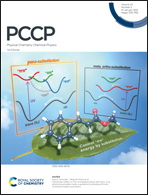Switching from an electride-like molecule to the molecular electride K-F6C6H6 driven by an oriented external electric field†
Abstract
The exploration of innovative molecular switches has resulted in large developments in the field of molecular electronics. Focusing on a single molecular switch with different forms exhibiting different electride features, potassium-atom-doped all-cis 1,2,3,4,5,6-hexafluorocyclohexane K-F6C6H6 was studied theoretically. It was found that an oriented external electric field can drive excess electron transfer from the region outside of the K atom to that outside of F6C6H6. Subsequently, the electride-like molecule K-F6C6H6 (1) switches into the molecular electride K-F6C6H6⋯e− (3) through another electride-like molecule K-F6C6H6 (2). The static first hyperpolarizabilities (β0) are increased over 12- and 5-fold when moving from 1 to 2 and 3, respectively. The rise of each β0 value constitutes an order of magnitude improvement. Between them, the different β0 values suggest that K-F6C6H6 is a good candidate for use as a multiple-response nonlinear optics switch. The order of the β0 values of 1–4 for M-F6C6H6 (M = Li and Na) coincide with that of K-F6C6H6, also exhibiting a switch effect.



 Please wait while we load your content...
Please wait while we load your content...